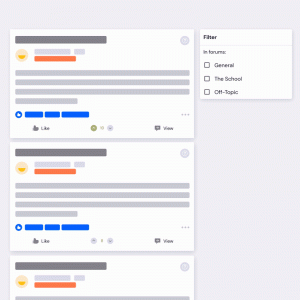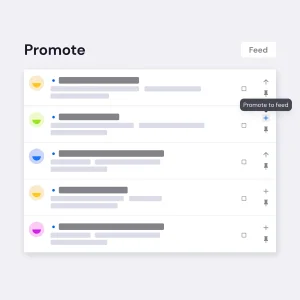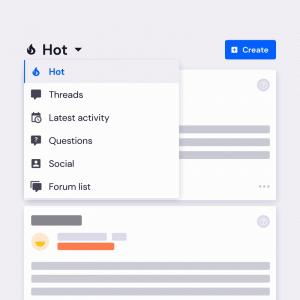Hey all!
I've been concerned with design, forums and online communities, themes and building engagement tools, and overall user interface and user experience for about half my life now. What started as a hobby is now a full career. But it wasn't really until covid hit that I took the time to step back and assess what it was that I was doing, not just in my career but also for the hundreds of communities that I am in many ways responsible for, in full or in part.
More recently, I've fallen out of love with the idea of themes governing the experience of forums. In fact, I almost cringe at the idea and how short sighted I was to think that themes can play such a vital role in and of themselves. And this is somewhat awkward to say considering one of the brands that my company Audentio built is ThemeHouse.com. But I had to find the true value that themes were providing. And let's face it, everyone needs a theme as its good to have branding and such, but are they actually useful? And by useful, I mean are they increasing engagement numbers? Are users registering and sticking around? Is the interface getting in the way and you have no way of knowing? Such questions can be hard to know for sure.
So, we set out to build a data integration tool between XenForo, the various add-ons we have, and Google Data Studio. We also built an AB Testing add-on to put users into 2 groups respectively in order to compare. We then setup graphs and various metrics to help answer some of these questions. While I will post more on this at a later date when some of our studies finish, suffice to say the theme had no real bearing on the success factors and KPIs (Key performance indicators) of the forums. In other words, putting a logo on the default XenForo theme was plenty to maintain the status quo.
Now of course there are other reasons, even just brand related, for having a unique theme. But what we learned was kinda shocking, and kind of at the same time kinda expected. Ultimately, the theme alone can only stand to hurt your forum, not really do much in the way of helping.
That all said, I think the experience (not just the theme) can play a vital role in increasing engagement. The experience I will define not just as the theme (colors, brand, navigation style, icons, "unique" special sauce), but that plus the platform itself, the added or unique functionality, the navigation, the content, the spacing, the user flows, the call-to-actions, the position of elements. All of these elements, working harminiously together, is the experience.
It will come as no surprise that if given the choice objectively, users prefer the experience of social media. After all its engineered to be as easy and simple as possible. But what I set out to do was to see if I can find middle ground; an experience that takes some of the must-haves from social media but also keeping the forum and small community's fundamental purpose in tact and undiluted, as social media is known for doing to content and ideas.
I'm not a great writer to be clear, but I wrote two pieces that I'd love some feedback on if anyone gets the time to. First, I look at the history of different improvements to the core UX of forums, specifically XenForo from the perspective of projects Audentio and ThemeHouse have worked on, just as a summary of success and failure, entitled Through the Ages: Content Discoverability UX on Forums. And the second, being specific implementations and improvements to this traditional UX model forums have been using for decades now, entititled How we improved the forum user experience by learning from social media.
Overall, its time we all get more serious about improving UX on forums and consider the entire UX not just the theme alone when building our communities. UX plays a huge role in seeing our communities be more successful. I think the age of small communities is coming back, and we all have a great opportunity to make sure we do right by the internet as a whole and the communities we serve.
Thanks for reading and looking forward to any feedback or thoughts on some of this work.
ETA: Added some cool images to at least roughly convey some of those UX decisions:



I've been concerned with design, forums and online communities, themes and building engagement tools, and overall user interface and user experience for about half my life now. What started as a hobby is now a full career. But it wasn't really until covid hit that I took the time to step back and assess what it was that I was doing, not just in my career but also for the hundreds of communities that I am in many ways responsible for, in full or in part.
More recently, I've fallen out of love with the idea of themes governing the experience of forums. In fact, I almost cringe at the idea and how short sighted I was to think that themes can play such a vital role in and of themselves. And this is somewhat awkward to say considering one of the brands that my company Audentio built is ThemeHouse.com. But I had to find the true value that themes were providing. And let's face it, everyone needs a theme as its good to have branding and such, but are they actually useful? And by useful, I mean are they increasing engagement numbers? Are users registering and sticking around? Is the interface getting in the way and you have no way of knowing? Such questions can be hard to know for sure.
So, we set out to build a data integration tool between XenForo, the various add-ons we have, and Google Data Studio. We also built an AB Testing add-on to put users into 2 groups respectively in order to compare. We then setup graphs and various metrics to help answer some of these questions. While I will post more on this at a later date when some of our studies finish, suffice to say the theme had no real bearing on the success factors and KPIs (Key performance indicators) of the forums. In other words, putting a logo on the default XenForo theme was plenty to maintain the status quo.
Now of course there are other reasons, even just brand related, for having a unique theme. But what we learned was kinda shocking, and kind of at the same time kinda expected. Ultimately, the theme alone can only stand to hurt your forum, not really do much in the way of helping.
That all said, I think the experience (not just the theme) can play a vital role in increasing engagement. The experience I will define not just as the theme (colors, brand, navigation style, icons, "unique" special sauce), but that plus the platform itself, the added or unique functionality, the navigation, the content, the spacing, the user flows, the call-to-actions, the position of elements. All of these elements, working harminiously together, is the experience.
It will come as no surprise that if given the choice objectively, users prefer the experience of social media. After all its engineered to be as easy and simple as possible. But what I set out to do was to see if I can find middle ground; an experience that takes some of the must-haves from social media but also keeping the forum and small community's fundamental purpose in tact and undiluted, as social media is known for doing to content and ideas.
I'm not a great writer to be clear, but I wrote two pieces that I'd love some feedback on if anyone gets the time to. First, I look at the history of different improvements to the core UX of forums, specifically XenForo from the perspective of projects Audentio and ThemeHouse have worked on, just as a summary of success and failure, entitled Through the Ages: Content Discoverability UX on Forums. And the second, being specific implementations and improvements to this traditional UX model forums have been using for decades now, entititled How we improved the forum user experience by learning from social media.
Overall, its time we all get more serious about improving UX on forums and consider the entire UX not just the theme alone when building our communities. UX plays a huge role in seeing our communities be more successful. I think the age of small communities is coming back, and we all have a great opportunity to make sure we do right by the internet as a whole and the communities we serve.
Thanks for reading and looking forward to any feedback or thoughts on some of this work.
ETA: Added some cool images to at least roughly convey some of those UX decisions:
Attachments
Last edited:






